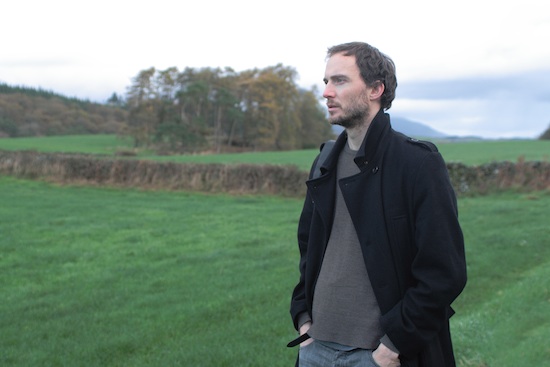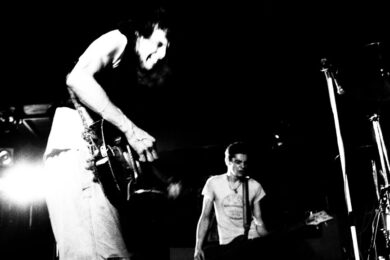Richard Skelton’s explorations of the human soul within the landscapes of the British Isles have made for some of the most eloquent and evocative music of recent times, and his recent concert at LSO St Lukes with the Elysian Quartet was one of the live highlights of the year. Now, he returns with a new project, The Inward Circles, and a refreshing new direction. His distinctive drones and rough sonics, the capturing of water over landscape and air moving past rock, have taken on a tougher, more electronic edge reminiscent of artists like Stephen O’Malley and Peter Rehberg’s KTL. Where before his music, and the beautiful books that he published to accompany them, might create images of the vast damp spaces of the north of England in a way that seemed to reflect the ambivalence of nature towards us fragile and fleshy mortals, The Inwards Circles is full of threat, things ancient and unknown appearing amidst the sphagnum moss and heather. It reminds me of the stark atmosphere of Ben Myers’ novel Beastings, one of the best books of 2014. With titles taken from 17th century writer Thomas Browne, the debut album from The Inward Circles is called Nimrod Is Lost In Orion And Osyris In The Doggestarre and is available from Skelton’s website here. Listen to the track ‘Ancient Arithmetic Of The Hand’ below, and read an interview with Skelton about the new project.
Why the idea to do new music under a new title, The Inward Circles?
Richard Skelton: Exactly that: new music, new title. After 2011’s *Skura, my twentieth self-released recording, I decided to ‘retire’ all the names I’d used previously. It was the closing of a chapter – but I still had the intent to use new names in the future. Part of the problem for artists who make instrumental music is that we’re denied the vocabulary of vocal music, so perhaps my use of different titles is a way of making up for this deficiency. Retrospectively – in terms of what I was trying to achieve – it was probably a mistake to release music under my ‘given’ name. This partly came about as a compromise that resulted from releasing music with another record label, and partly because I began to associate the music with written works, and it somehow felt appropriate to attribute the books (and therefore the music) to ‘Richard Skelton’, rather than ‘Carousell’ or ‘A Broken Consort’. My continued use of multiple, ephemeral pseudonyms is probably commercial self-sabotage – but, ultimately, we must follow our instincts. Funnily enough, the book that comes with Nimrod is published under ‘The Inward Circles’, rather than my own name…
When did this music begin to take shape? Was there any change in instrumentation to previous records? It almost feels like something more electronic, but excuse my ignorance if this isn’t the case.
RS: I’ve been working on it since returning to Cumbria from Ireland in 2011. Shortly thereafter I had the good fortune to borrow a cello from a local luthier – I had always wanted to play one, and had often sought to imitate its sound in the past by restringing and detuning other, smaller instruments. I also acquired a clarinet – again, an instrument I’d never played before – so I slowly began working with these two instruments over the next 18 months.
With regard to the sound – you’re absolutely right in the sense that I wanted to obliterate the acoustic sources for this new record. The sounds of cello and clarinet are therefore subject to much more ‘treatment’ – although it’s not without precedent. For example, there are electronic elements to my ‘Heidika’ recordings from 2005 and 2007, and the last track on last year’s Succession album – used distortion in a similar manner to Nimrod.
Was there a difference in research and process?
RT: The last three years in the Cumbrian mountains have been pretty bleak. It seems to be always raining, and when there’s no rain, there’s mist. And there are terrific winds which howl around the cottage, blowing down trees and fences, and sending loose debris flying. I therefore wanted to create a music that somehow reflected these processes – to imagine sound as a physical substance that had endured weathering, just as these hills have endured, for millennia. This involved using various techniques that explored sound degradation, including playing recorded cello parts at high volume and then recording the vibrations that were transmitted through sheets of wood and metal.
As a consequence, percussive thuds and scrapes are perhaps more prominent on Nimrod… than on any of my previous recordings – I imagined these as spurs and outcrops of a more obdurate substrate, revealed as the surface material is gradually rubbed away.
It’s interesting you talk about ‘imaginary landscapes’ – I find this work harder to place in the landscape than past Richard Skelton music. In a way it makes me think of artists like Stephen O’Malley and Peter Rehberg’s KTL or the ambient fringes of black metal, which perhaps evoke ancient pasts that never existed, or deathly places, or cinematic horror. Am I going on a tangent here or do you feel that’s a reading that makes sense?
RS: I think I wanted to draw attention to the role that the imagination plays, even when dealing with ‘real world’ landscapes. For myself, over the past half-decade, I’ve begun to notice how imperfectly the external world is mapped in my mind – but, far from being a flaw, it is a facility which allows me to make free connections between disparate things. So, the imaginative landscape I hold in my head contains a patchwork of different real-world places, all quite distorted, extended and enmeshed. In fact, it may be that our inner worlds comprise many different landscapes superimposed on one another, so that we can walk from one to another at will. The imagination knows no decorum – it is not restricted by geographical proximity.
This summer, I read Dorothy Wordsworth’s journals, and was struck by the line "walked, I know not where". These words seemed to brim with pathos, and also suggested that blurring of the outer and imaginal worlds; that she had wandered in two landscapes at the same time. It made me remember that I often walk the same circuit here in the valley, and that I sometimes return home without any real memory of it, because my mind has been ‘somewhere else’. This is where the phrase ‘The Inward Circles’ seemed to resonate.
It was this sense of the convergence of the interior and exterior that I wanted to evoke with Nimrod. The accompanying book contains extracts from various writers, including W.H. Hudson, Thomas de Quincey, Christina Rossetti and Thomas Browne, each of whom, in their own way, representing a kind of hyper-sensitivity to nature itself. You could perhaps characterise it as an exploration of the pathetic fallacy, aptly summed up in Gerard Manley Hopkins words "nature in all her parcels and faculties gaped and fell apart".
What can you tell us about Thomas Browne, whose work supplied you with the titles? Why does his writing inspire you?
RS: In all honesty I find Browne – with his classical and biblical allusions – fairly impenetrable. Nevertheless, I think his Garden Of Cyrus is perhaps unintentionally poignant because it is a fundamentally flawed attempt to elicit a simple set of rules that govern the geometry of nature. 350 years later, we are still trying to apply theories to the natural world, and with each generation the unshakeable truths of the past are called into question. I also find his reflections on mortality and longevity in Urn Burial profoundly moving – as he relates how even kings and gods are forgotten: "there is no antidote to the opium of time, which temporally considers all things; our fathers find their graves in our short memories, and sadly tell us how we may be buried in our survivors. Grave-stones tell truth scarce forty years. Generations pass while some trees stand, and old families last not three oaks… the iniquity of oblivion blindly scatters her poppy, and deals with the memory of men without distinction to merit or perpetuity… Nimrod is lost in Orion, and Osyris in the Doggestarre."
What are your plans for the near future?
RS: I recently had the good fortune to spend a month’s residency in an Icelandic fjord. I found the landscape – and the isolation – incredibly inspiring, and recorded a good deal of music. As I didn’t have any acoustic instruments, the sound is quite different from any of my previous work – it is much more noticeably electronic, layered with field recordings of industrial machinery (there was a remarkable hydro-electric dam at the head of the fjord). So I’ll be working on those recordings over the coming weeks – hopefully with a view to releasing them soon.



